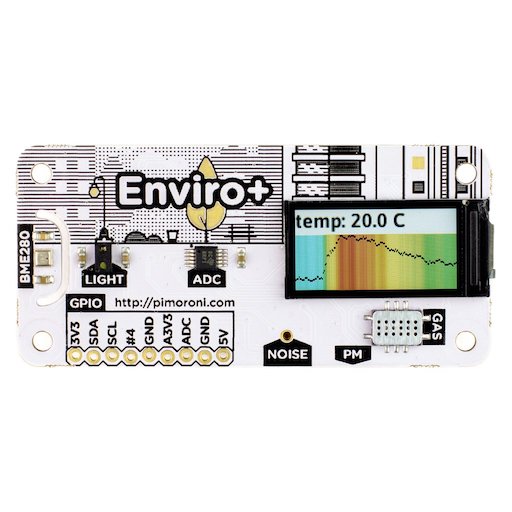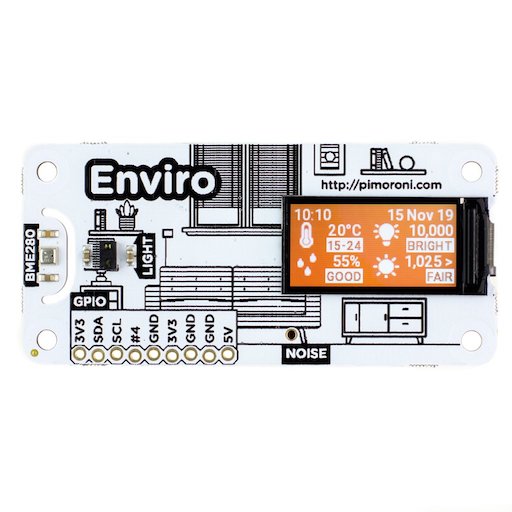Designed for environmental monitoring, Enviro+ lets you measure air quality (pollutant gases and particulates), temperature, pressure, humidity, light, and noise level. Learn more - https://shop.pimoroni.com/products/enviro-plus
Note The code in this repository supports both the Enviro+ and Enviro Mini boards. The Enviro Mini board does not have the Gas sensor or the breakout for the PM sensor.
git clone https://github.com/pimoroni/enviroplus-pythoncd enviroplus-python./install.sh
Note Libraries will be installed in the "pimoroni" virtual environment, you will need to activate it to run examples:
source ~/.virtualenvs/pimoroni/bin/activate
Note Raspbian/Raspberry Pi OS Lite users may first need to install git: sudo apt install git
python3 -m venv --system-site-packages $HOME/.virtualenvs/pimoroni- Run
python3 -m pip install enviroplus
And install additional dependencies:
sudo apt install python3-numpy python3-smbus python3-pil python3-setuptoolsNote this will not perform any of the required configuration changes on your Pi, you may additionally need to:
- Enable i2c:
raspi-config nonint do_i2c 0 - Enable SPI:
raspi-config nonint do_spi 0
And if you're using a PMS5003 sensor you will need to:
- Enable serial:
raspi-config nonint do_serial_hw 0 - Disable serial terminal:
raspi-config nonint do_serial_cons 1 - Add
dtoverlay=pi3-miniuart-btto your/boot/config.txt
- Enable serial:
raspi-config nonint set_config_var enable_uart 1 /boot/config.txt - Disable serial terminal:
sudo raspi-config nonint do_serial 1 - Add
dtoverlay=pi3-miniuart-btto your/boot/config.txt
- Enviro Plus Dashboard - https://gitlab.com/dedSyn4ps3/enviroplus-dashboard - A React-based web dashboard for viewing sensor data
- Enviro+ Example Projects - https://gitlab.com/dedSyn4ps3/enviroplus-python-projects - Includes original examples plus code to stream to Adafruit IO (more projects coming soon)
- enviro monitor - https://github.com/roscoe81/enviro-monitor
- mqtt-all - https://github.com/robmarkcole/rpi-enviro-mqtt - now upstream: see examples/mqtt-all.py
- enviroplus_exporter - https://github.com/tijmenvandenbrink/enviroplus_exporter - Prometheus exporter (with added support for Luftdaten and InfluxDB Cloud)
- homekit-enviroplus - https://github.com/sighmon/homekit-enviroplus - An Apple HomeKit accessory for the Pimoroni Enviro+
- go-enviroplus - https://github.com/rubiojr/go-enviroplus - Go modules to read Enviro+ sensors
- homebridge-enviroplus - https://github.com/mhawkshaw/homebridge-enviroplus - a Homebridge plugin to add the Enviro+ to HomeKit via Homebridge
- Enviro Plus Web - https://gitlab.com/idotj/enviroplusweb - Simple Flask application serves a web page with the current sensor readings and a graph over a specified time period
- GPIO Pinout - https://pinout.xyz/pinout/enviro_plus
- Support forums - https://forums.pimoroni.com/c/support
- Discord - https://discord.gg/hr93ByC











